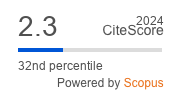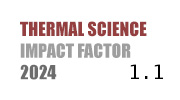THERMAL SCIENCE
International Scientific Journal
Thermal Science - Online First
online first only
Synergistic effect on combustion kinetics and ash fusion characteristics during co-combustion of bituminous coal and wheat straw
ABSTRACT
In this study, the combustion behavior, synergistic effect and ash characteristics during the co-combustion of bituminous coal and wheat straw were fully analyzed by thermogravimetric analyzer, ash melting point analyzer, X-ray diffraction and scanning electron microscope. Thermogravimetry analysis showed that wheat straw was easier to be ignited, showing higher devolatilization activity and lower thermopositive temperature. Co-combustion displayed volatiles and char combustion stage and showed lower combustion rate compared to mono-combustion. For the wheat straw blending ratio≤50%, significant positive synergistic effect was observed during the volatiles combustion stage while negative synergistic effect was found during the char combustion stage. With wheat straw blending, the co-combustion ash fusion temperature first increased and then decreased. The mineral components of co-combustion ash gradually changed from high ash melting point compounds to complex calcium silicate hydrate. The morphology of co-combustion ash turned from hard flake structure to loose porous structure, showing partial melting in the biomass derived pores. Small addition of wheat straw during co-combustion would be beneficial to enhance the ash fusion temperature and optimize combustion performance.
KEYWORDS
PAPER SUBMITTED: 2025-03-14
PAPER REVISED: 2025-06-18
PAPER ACCEPTED: 2025-06-19
PUBLISHED ONLINE: 2025-08-02
- Deonarine, A., et al., Environmental Impacts of Coal Combustion Residuals: Current Understanding and Future Perspectives. Environmental Science & Technology, 2023. 57(5): pp. 1855-1869
- Antar, M., et al., Biomass for a sustainable bioeconomy: An overview of world biomass production and utilization. Renewable and Sustainable Energy Reviews, 2021. 139: pp. 110691
- Mureddu, M., et al., Air-and oxygen-blown characterization of coal and biomass by thermogravimetric analysis. Fuel, 2018. 212: pp. 626-637
- Moon, C., et al., Effect of blending ratio on combustion performance in blends of biomass and coals of different ranks. Experimental Thermal and Fluid Science, 2013. 47: pp. 232-240
- Jayaraman, K., et al., Thermogravimetric and mass spectrometric (TG-MS) analysis and kinetics of coal-biomass blends. Renewable Energy, 2017. 101: pp. 293-300
- Oladejo, J. M., et al., In-situ monitoring of the transformation of ash upon heating and the prediction of ash fusion behaviour of coal/biomass blends. Energy, 2020. 199: pp. 117330
- Zhang, L., et al., Influence of biomass ash additive on fusion characteristics of high-silicon-aluminum coal ash. Fuel, 2020. 282: pp. 118876
- Unchaisri, T. and Fukuda, S., Investigation of ash formation and deposit characteristics in CFB co-combustion of coal with various biomass fuels. Journal of the Energy Institute, 2022. 105: pp. 42-52
- Taghizadeh-Alisaraei, A., et al., Potential of biofuels production from wheat straw biomass, current achievements and perspectives: a review. Biofuels, 2023. 14(1): pp. 79-92
- Chaudhuri, P., et al., Unravelling bioenergy potential of bamboo and bamboo bio-char through thermogravimetric analysis. Energy Sources, Part A: Recovery, Utilization, and Environmental Effects, 2025. 47(1): pp. 10601-10612
- Milićević, A., et al., Mathematical modelling and optimisation of lignite and wheat straw co-combustion in 350 MWe boiler furnace. Applied Energy, 2020. 260: pp. 114206
- Wang, Q., et al., Reactivity and Kinetic Analysis of Biomass during Combustion. Energy Procedia, 2012. 17: pp. 869-875
- Tong, W., et al., Experiment and expectation: Co-combustion behavior of anthracite and biomass char. Bioresource Technology, 2019. 280: pp. 412-420
- Zhu, L. and Zhong, Z., Effects of cellulose, hemicellulose and lignin on biomass pyrolysis kinetics. Korean Journal of Chemical Engineering, 2020. 37(10): pp. 1660-1668
- Caliskan Sarikaya, A., et al., Synergistic Interactions During Cocombustion of Lignite, Biomass, and Their Chars. Journal of Energy Resources Technology, 2019. 141(12): pp. 122203
- Kastanaki, E. and Vamvuka, D., A comparative reactivity and kinetic study on the combustion of coal-biomass char blends. Fuel, 2006. 85(9): pp. 1186-1193
- Cong, H., et al., Evaluating the performance of honeycomb briquettes produced from semi-coke and corn stover char: Co-combustion, emission characteristics, and a value-chain model for rural China. Journal of Cleaner Production, 2020. 244: pp. 118770
- He, Z.-M., et al., Review of Biomass Agglomeration for Fluidized-Bed Gasification or Combustion Processes with a Focus on the Effect of Alkali Salts. Energy & Fuels, 2022. 36(16): pp. 8925-8947
- Yang, G., et al., Co-melting properties and mineral transformation behavior of mixtures by MSWI fly ash and coal ash. Journal of the Energy Institute, 2021. 96: pp. 148-157
- Che Pa, F. and Mohamad Nasir, N. N. Synthesis of Zeolite from Rice Husk Ash. in Proceedings of the Green Materials and Electronic Packaging Interconnect Technology Symposium. 2023. Singapore: Springer Nature Singapore
- Deng, S., et al., Ash fusion characteristics and mineral matter transformations during sewage sludge/petrochemical sludge co-firing with wheat straw. Journal of Cleaner Production, 2020. 260: pp. 121103
- Wang, T., et al., Regulation of ash slagging behavior for sewage sludge by rice husk addition: Focusing on control mechanisms. Journal of Cleaner Production, 2021. 284: pp. 124677
- Lu, Y., et al., Investigation on the ash characteristics and AAEM migration during co-combustion of Zhundong coal and shale char in a fixed bed. Fuel, 2022. 327: pp. 125214
- Xiao, H., et al., Effect of potassium-containing sulfates on high-temperature mineral transformation and coal ash fusibility. Energy Sources, Part A: Recovery, Utilization, Environmental Effects, 2024. 46(1): pp. 12496-12511

